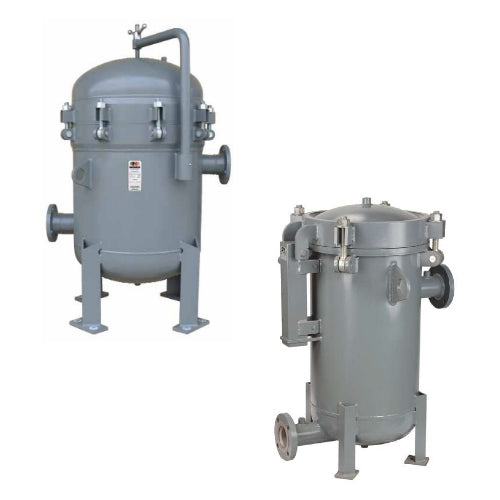Regular inspection and maintenance of your filter bag housing(s) are required to maintain the functionality of your equipment. Frequently check temperature and pressure gauges to ensure your system is operating within manufacturer guidelines, and inspect equipment for corrosion. Replace filters and gaskets as needed and maintain lubrication on all moveable parts. These steps will contribute to the longevity and functionality of your filtration equipment.
How to Maintain a Filter Bag Housing
In order to maintain the life of your filter bag housings, maintenance, both regular and as-needed, is required. It’s important to note that work should never be done on these filters and housings until the system is shut down completely and the pressure is released. Failing to release pressure could result in damage to the filter or injury to the employee. Only trained and authorized employees should maintain this equipment.
Regularly Check for Damage to the Filter Housing

Filter bag housings can be used for a wide variety of applications and liquids. First, ensure that you are using the correct housing for the liquid you plan to filter. Some questions to consider are: 1) Do you need a single bag housing (such as these) or multi-bag housing (such as these)? 2) Do you need a housing that is stainless steel, carbon steel, or another body material type? 3) Do your end connections need to be threaded, flanged, or welded?
Once you have determined the proper filter bag housing and have been using it in your process, regularly inspect the system to find any signs of corrosion or other damage caused by the liquid passing through. In addition to inspecting the housing, look for damage to the gaskets and seals as well. Replace corroded parts as soon as possible to maintain the safety and functionality of the filtration system.
Monitor Temperature and Pressure Gauges
The temperature and pressure of the liquid you filter must also be regularly checked. A temperature gauge should be installed to monitor the changing temperature of the liquid you are filtering, in addition to a pressure gauge. Increased pressure may be an indicator that the filter needs to be cleaned or replaced, but it could also be a sign that other maintenance is required. Each filter housing has its own pressure specifications, and it’s important to know this information as you monitor and inspect your filtration system. In many cases, a brief and controlled pressure increase can be tolerated, but longer, sustained high pressure could damage the system.
As previously mentioned, increased pressure at the entry point of the filter is a strong indicator that the filter inside the housing needs attention. Shut off the system and release all pressure. Depending on the type of filter you are using, you can either clean it or replace it completely. Be sure that the bag is locked into place and the housing is closed before turning the system back on.
Replace Damaged Filter Housing Gaskets

Prior to system use, verify that the size and material of your gaskets is appropriate for your filtration application. During regular maintenance, check that gaskets and sealing surfaces are clean and free from damage. If any damaged gaskets are found, they should be replaced immediately. Many manufacturers recommend replacing gaskets each time a pressurized housing is opened to avoid a faulty seal.
Properly Lubricate Movable Parts
Filter housings with movable parts require frequent lubrication. Stainless steel bolts and threads can be easily lubricated with common grease to ensure easy movement and longevity, though over-greasing could cause damage. Refer to the manufacturer’s specifications about additional features, including lock systems or spindle closures, which may also need to be lubricated.
Regularly Test Security Equipment
Your best defense against system malfunction is its security equipment, including pressure gauges, relief systems, locking devices, temperature control devices, and leak warning systems. Each should be regularly tested to ensure optimum functionality. Replace all broken security equipment immediately.
Storing a Filter Bag Housing
Another way to maintain filter bag housings is by properly storing them when not in use. All filter bags and housings should be stored in a secure location, away from any corrosive products. Store housings with the openings plugged to ensure the interior of the housing is clean and free of contaminants. In some applications where a sterile housing is critical, an inert gas, such as nitrogen, may be needed to be sure the housing has not been in contact with any potentially harmful contaminants.
Filter Bag Housing Maintenance
To maintain the optimal functionality of your filtration system, consistent monitoring and regular maintenance of your filter bag housing is required. Inspect equipment for corrosion and other visible damage. Check to make sure the temperature and pressure inside your housing meet manufacturer’s guidelines as well, and if needed, clean or replace the filter. Gaskets may also need to be replaced to avoid a faulty seal, while all moveable parts should be lubricated. Inspecting security equipment is also essential to maintain the functionality of your filtration system. Contact Commercial Filtration Supply to learn more about the maintenance of your filter bag housings and other filtration equipment.

